
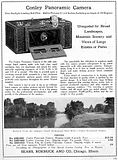
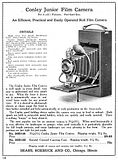
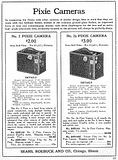
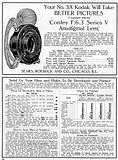
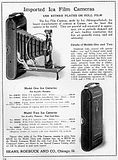


Sears Roebuck & Co., in the early years of the Twentieth Century, may have been Kodak's stiffest domestic competitor in the marketing of photographic technology and services. The mail order company's giant catalog had a large section devoted to cameras and darkroom equipment. The items sold were from domestic and imported sources, and were similar to Kodak's offerings in regard to features, quality and pricing. Sears imported some high quality cameras from Germany including models from ICA A.G. which became a part of the Zeiss Ikon conglomerate in 1926. At the lower end of the consumer scale, Sears relied initially on cameras from the Conley Camera Co. of Rochester, Minn, which were sometimes marketed under the "Seroco" label.
Sears and Kodak competed for the affections of amateur photographers with magazines published monthly and sold for five cents a copy. Both publications, appearing first in 1913, were twenty-five or thirty pages in length and very similar in regard to design, layout and subject matter. The Kodak offering, KODAKERY, was published at the company headquarters in Rochester, NY and had somewhat of an edge over Sears' Better Photos in terms of design style, as well as in the quality of the typography and photo reproductions. Articles in both magazines focused on photo technique and photo subjects of concern to the amateur audience including hints on making portraits of family members, children and pets, along with sports, landscape and snow scenes. Sears offered film and plate processing from its Chicago headquarters, as well as the making of prints and enlargements; an 8x10 could be had for fifteen cents, and for another six cents, you could have it mounted.
Until "miniature" 35mm cameras started to get popular in the mid 1920's, most consumers were content to get their snapshots made into contact prints. While Sears and other companies offered enlarging services, few amateurs in the first decades of the Century would have had the capability of making their own enlargements. For the advanced amateurs with adequate finances or mechanical skills, however, there were options available. An article in the Vol.1, No.2 issue of Better Photos illustrated a method for using a folding camera as an enlarger for making prints from glass plate negatives. Mounting the contraption on a window with a light-gathering mirror was probably a very practical idea at a time when electric lighting still had limited availability.
The editorial staff of Better Photos also conducted a twelve-lesson Correspondence School of Photography which was often advertised on the inside front cover of the magazine. The ad ended with the assurance that
"The student will not be hurried nor urged to complete the course in less time than is necessary to secure a thorough knowledge of the principles of photography, and lessons may be returned for criticism and correction as many times as the student desires, or until proficiency is attained."The price for all of that was $3.00. Even after applying the 20x factor for inflation since 1913, it seems a pretty good deal.
The range of prices for cameras adjusted for inflation seems very similar to what is offered to consumers today. In 1913, box cameras sold for the equivalent of about $40 in today's inflated dollars. Domestic folders with faster lenses and multi-speed shutters went for about $200, while top-of-the-line imports sold for around $1000 in current dollar value.
home vintage cameras photo ephemera
 © mike connealy
© mike connealy